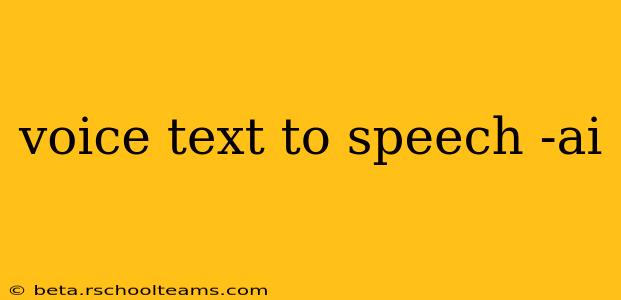The world of voice text to speech (TTS) AI is rapidly evolving, offering increasingly natural-sounding and versatile solutions for various applications. From accessibility tools for individuals with visual impairments to innovative communication solutions for businesses, the capabilities of AI-powered TTS are transforming how we interact with technology. This comprehensive guide delves into the intricacies of voice text to speech AI, exploring its functionalities, benefits, limitations, and future potential.
What is Voice Text to Speech (TTS) AI?
Voice text to speech AI uses artificial intelligence to convert written text into spoken audio. Unlike older, robotic-sounding TTS systems, modern AI-powered solutions leverage deep learning algorithms and vast datasets of human speech to generate more natural and expressive speech. This technology analyzes the nuances of language—intonation, stress, pauses, and emotion—resulting in significantly improved audio quality and comprehension.
How Does Voice Text to Speech AI Work?
The process involves several key steps:
- Text Preprocessing: The input text is cleaned and prepared for processing. This includes handling punctuation, numbers, and special characters.
- Text Analysis: The system analyzes the text's grammatical structure, identifying sentences, phrases, and individual words. It also identifies potential ambiguities and context clues.
- Phoneme Conversion: The text is converted into phonemes, the basic units of sound in a language. This step often involves using a pronunciation dictionary and language models.
- Prosody Assignment: The system assigns prosodic features such as intonation, stress, and rhythm to the phonemes. This is crucial for creating natural-sounding speech.
- Speech Synthesis: The system uses a speech synthesizer, often based on neural networks, to generate the audio output from the processed phonemes and prosody information. This involves manipulating waveforms and acoustic models to produce realistic speech.
- Output: The final audio output is generated, ready for playback or other applications.
What are the different types of Voice Text to Speech AI?
There are several approaches to TTS synthesis:
- Concatenative Synthesis: This approach joins pre-recorded speech units (phonemes, syllables, or words) to form sentences. While relatively simple, it can sound unnatural due to potential discontinuities between units.
- Parametric Synthesis: This method creates speech from parameters that describe the acoustic properties of speech, offering greater control over the synthesis process. However, it requires complex modelling.
- Neural Text-to-Speech (Neural TTS): This cutting-edge technology utilizes deep neural networks, significantly enhancing the naturalness and expressiveness of the generated speech. It often involves end-to-end models that directly map text to speech waveforms.
What are the benefits of using Voice Text to Speech AI?
- Improved Accessibility: TTS makes digital content accessible to individuals with visual impairments or reading difficulties.
- Enhanced Communication: It enables seamless communication across various platforms and devices.
- Increased Productivity: It automates tasks such as reading aloud documents, creating audiobooks, and providing voice guidance.
- Personalized Experiences: AI-powered TTS can create personalized voices, enhancing user engagement.
- Multilingual Support: Many TTS systems offer support for multiple languages, broadening their reach and applicability.
What are the limitations of Voice Text to Speech AI?
- Accuracy: While accuracy has significantly improved, errors can still occur, particularly with complex or nuanced language.
- Naturalness: Achieving perfectly natural-sounding speech remains a challenge, although significant progress has been made.
- Emotional Expression: While some systems can convey basic emotions, expressing a full range of human emotions remains a complex problem.
- Computational Resources: High-quality TTS often requires significant computing power.
- Data Requirements: Training high-performing TTS models requires substantial amounts of high-quality speech data.
What are some common applications of Voice Text to Speech AI?
- Assistive Technology: Screen readers for visually impaired individuals.
- Education: Creating interactive learning materials and providing text-to-speech for students.
- Entertainment: Producing audiobooks, podcasts, and voiceovers for videos.
- Customer Service: Providing automated voice responses and virtual assistants.
- Automotive Industry: In-car navigation systems and voice-activated controls.
What is the future of Voice Text to Speech AI?
The future of voice text to speech AI is bright. We can anticipate even more natural-sounding speech, improved emotional expression, personalized voices, and wider multilingual support. The integration of TTS with other AI technologies, such as natural language processing (NLP), will lead to even more sophisticated and versatile applications. Expect to see continued advancements in efficiency and accessibility as research progresses and computational resources become increasingly powerful.
This comprehensive guide provides a detailed overview of voice text to speech AI, highlighting its current capabilities and potential future developments. As this field continues to advance, we can expect even more innovative and impactful applications to emerge.
